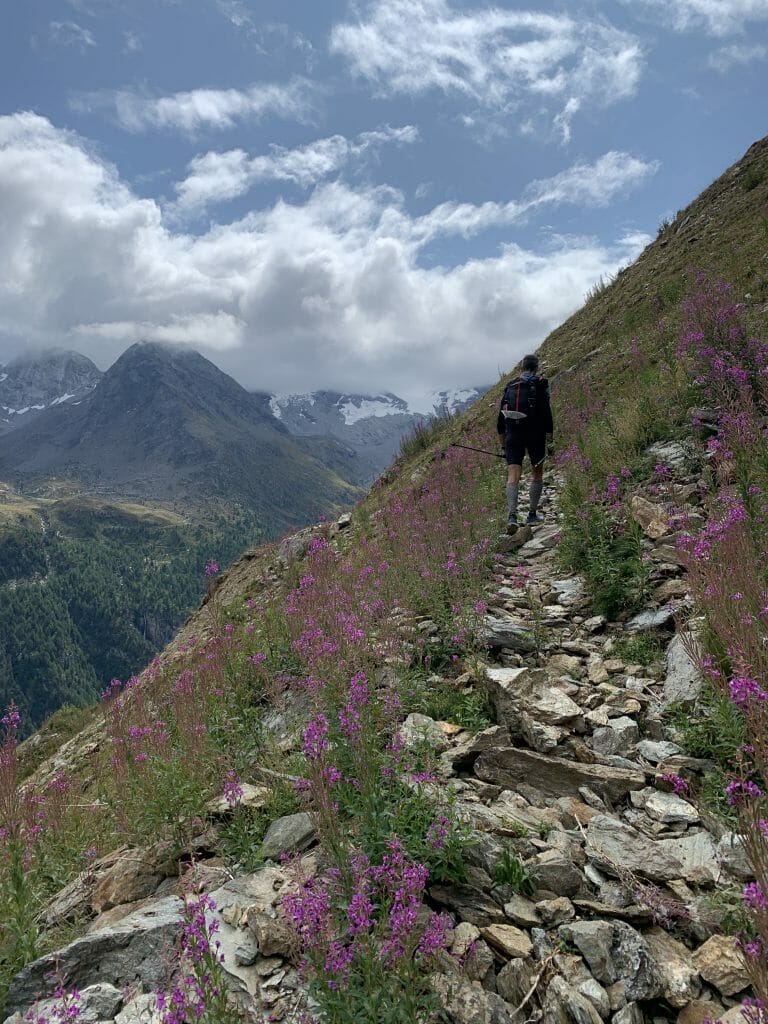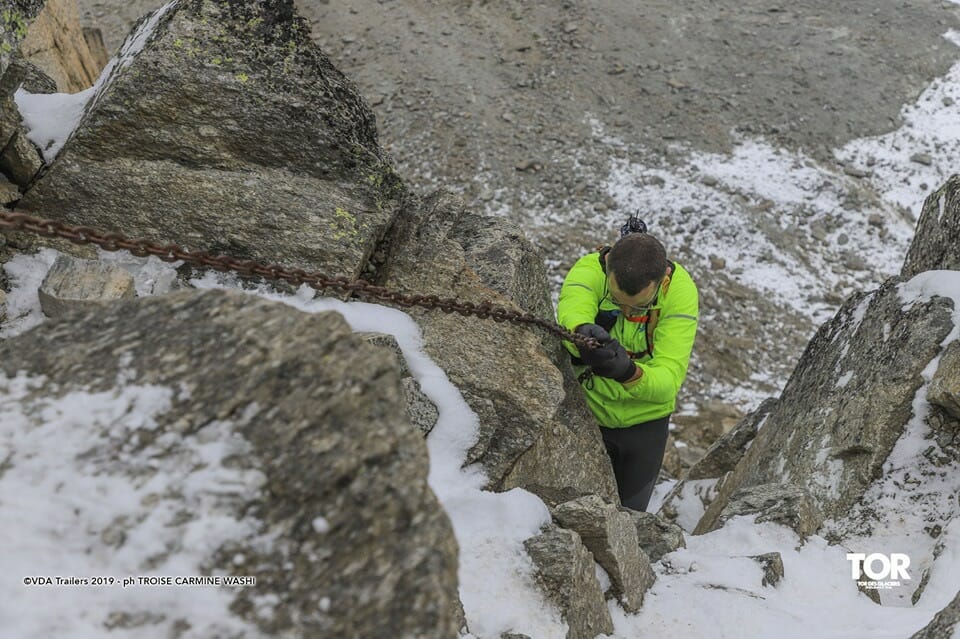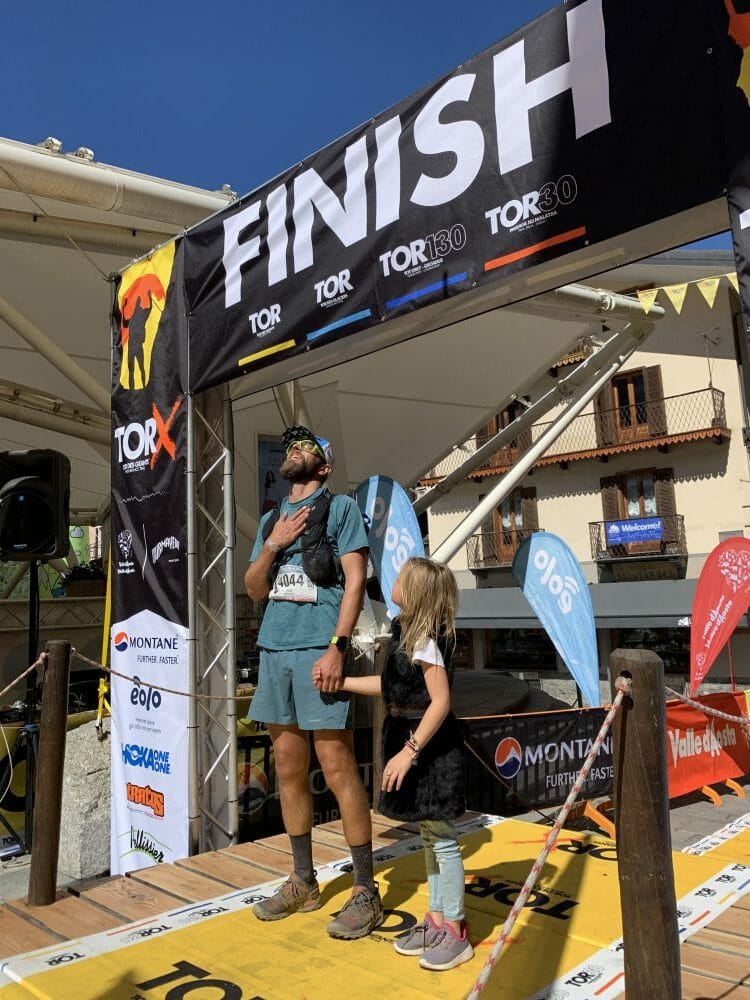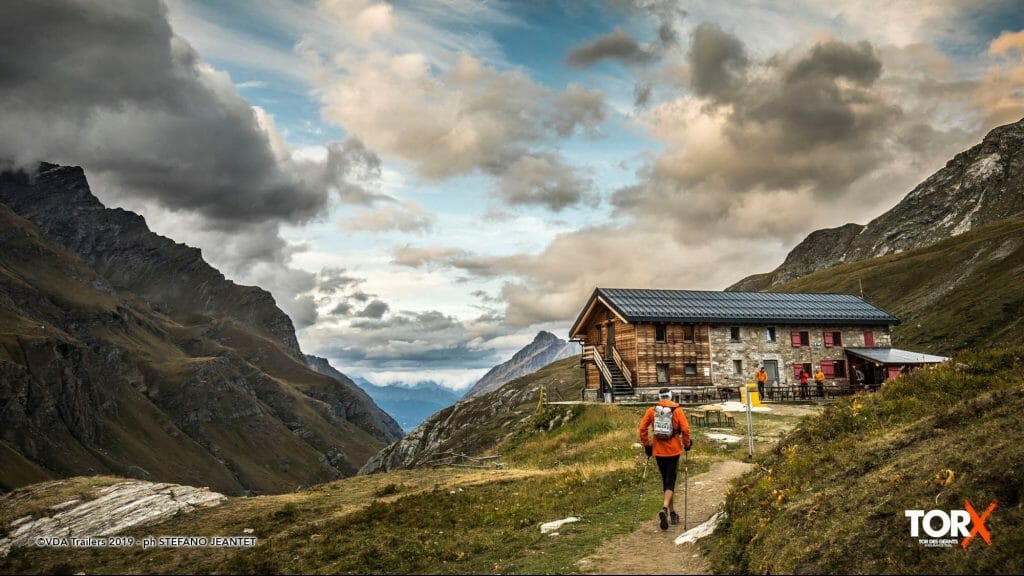It was morning, full sun. I was on the second-to-last descent, just 20 kilometers from Courmayeur. There were 430 jagged kilometers behind me.
Up to this point, I had successfully managed each transitory wave of pain, tiredness, and hunger. I’d handled frigid temperatures and tricky, middle-of-the-night navigation. I controlled what I could and accepted what I could not. Moving forward was what I did.
After six days of rolling with it all, my body picked this moment to rebel—on a well-maintained trail in broad daylight super close to the finish. Suddenly the only stride I could muster was an inefficient jig-hop. I grew frustrated with how slow I was going. There was no more acceptance.
As I made my way awkwardly down the grade, I took a header and landed squarely on one of my poles. It broke at the handle. I sat down heavily on a rock to regroup. I had come so far, yet the few thousand feet of elevation loss in front of me seemed farther still.
* * *
This wasn’t my first time competing in a long race in this region. In 2016, I ran my first Tor des Geants, a 330-kilometer (205-mile) race that circles Italy’s Aosta Valley on the backside of Mont Blanc, passing near Gran Paradiso, Monte Rosa, and the Matterhorn. The event is unique in every respect: the sheer distance of it, the variable climate, the challenging terrain, the sleep deprivation that comes from being out there for so long. It was an experience unlike any other—complex in the planning, beautifully simple in the running.
Completely hooked, I went back to the race in 2018. That’s when I heard rumblings that the following year, for the race’s tenth anniversary, the organization would offer an even longer event, the Tor des Glaciers—450 kilometers (280 miles) with 32,000 meters (105,000 feet) of elevation gain/loss. It would be unmarked—no flagging—and a little more technical in nature, featuring sections of fourth- and fifth-class terrain. Between that, the navigation, and even less sleep, it would demand my full attention.
I jumped at the chance.

Heading up to Lago di San Grato.
I’ve been running my entire life, from when I was a kid tromping around the mountains to cross-country in high school, road marathons after college, then trail ultras. The more ultras I did, the more I found myself drawn to longer alpine events—races like Hardrock and the Tor des Geants. Races that involve more than just running. However, even as my running evolved, my training stagnated. I knew there had to be a smarter way to prepare for these things.
That sense solidified when I turned 40. In late 2018, looking for a change, I reached out to Uphill Athlete’s Scott Johnston for one-on-one coaching. It just happened that Tor des Glaciers was the primary training goal for the following year. He took me on as a client and helped prepare me for this new event.
I live in Truckee, California, near Lake Tahoe—right in the heart of my training. After my usual winter of ski mountaineering, Scott transitioned me to running. That spring we focused on building my aerobic engine. The mileage wasn’t much different from what I was used to, but I spent much more time on my feet, carefully monitoring the effort of each workout. I also did a lot of steep climbing on technical terrain. It’s one thing to run hills. It’s another to seek out 35 percent grade to train on. For supportive strength, I did core work and a muscular endurance routine.
Scott was very accommodating when it came to piecing the training into the rest of my life. My wife, Janel, and I have four kids; the youngest is 8, the oldest is 13. They always come first. Then there’s my job as an ER doctor, which actually affords me some flexibility because it isn’t a traditional 8-to-5. There’s never “balance” in the sense that everything and everyone gets equal attention all the time. Leading up to Tor des Glaciers, there were certain points where I had more time in the day to dedicate to training, and certain times I didn’t.
If getting it done meant running early in the morning or later at night, after the kids were tucked away, that’s what I did.
Janel, our daughter Gretal, my mother-in-law, and I arrived in Europe a week before the race. It was enough time to get over jet lag and catch up with friends in Chamonix and Courmayeur. Our other three kids were back in Truckee with my parents and brother, ready to follow my tracking dot on the computer screen. Janel and I have been traveling to the Alps for a few years now. Rather than wrangle all the kids each trip, we decided to bring one at a time, starting with the oldest and working our way to Gretal, the youngest. It’s pretty special for each kid to spend a few weeks alone with us, where they get this rare experience of being an only child.
Janel, Gretal, and my mother-in-law would crew me along the course at each of the three larger aid station checkpoints, or “life bases.” That’s also where I’d have access to my duffel of race gear (fresh shoes, food, etc.). Between the life bases, spaced every 20–25 kilometers, the region’s traditional mountain huts—rifugios—would serve as informal aid stations. A mountain runner herself, Janel planned to run in to meet me at several of these while my mother-in-law looked after Gretal.
I’ve always had a tendency toward independence and self-reliance. But as these long races have taught me, acknowledging my vulnerability and accepting help—especially from my family—can make for an overall richer, fuller experience. I show my cracks, they help me fix them.
Just as the sun was going down on Friday, September 6, I headed off to find some dragons. My plan for the first half of the race was to be more conservative—move in an efficient but measured way, see how my body was responding, maybe sleep more than I thought I might need. Because this was a first-time event, an untried course, my main goal was to finish.
Our hundred-runner group spread out quickly on the initial two climbs out of Courmayeur. As night wore on, I found myself mostly alone in the snow, rain, and wind. Apart from the odd racer I’d encounter at the rifugios, I would continue to run solo for the rest of the week.
It stayed cold over the next day or so, and then the day after that it plunged well below freezing and snowed some more. At one point I was wearing my down coat, my rain pants, and my shell—every layer I had. Fortunately, that was the coldest it got. It began to warm up and dry out on day three, and after one final, drenching rain, the weather stayed pretty perfect.
I became fully immersed in this little world of moving through the mountains. The conditions were what they were, and I stopped thinking in terms of time and distance. There was no “A hundred hours and 250 kilometers to go!” Those variables lost their usual meaning, collapsing into the immediacy of the experience. I observed them as passing scenery and the flow of one day into the next. The sun came up and the sun went down. I climbed, descended, climbed, descended. I ate when I was hungry, snatched the occasional restless sleep when I grew tired. Huge meals at the rifugios became the norm: lasagna, gelato, pizza, polenta—1,000 delicious calories shoved in all at once without any GI issues.
My body was running and I was inside of it. Fatigue came and went, same with aches and pains. I experienced it all differently than how I would on a normal run, almost at a distance, as if floating both within and above it. Part of that was the sleep deprivation. As you move farther and farther on minimal sleep, things don’t happen the same way.
That included hallucinations. A rock became a ship rising from the landscape. A grassy field transformed into waves coming toward me, as if I was in the ocean. I watched conversations happen that I knew weren’t happening.

One of the technical descents.
Similar to time and distance and pain and fatigue, I almost didn’t think of the highs and lows as highs and lows. There were some really dark times, usually in the night, when things were just dark. And there were some sketchy moments, like when I found myself laughing inappropriately while downclimbing a steep, iced-up via ferrata in the Gran Paradiso area. But I didn’t judge those experiences. They just happened to me.
I was so locked into the moment that I remained cushioned from the totality of what I was doing. There was never a question of finishing. My legs were beat up and there was weird swelling and pain, but they continued to feel strong on the climbs. The kilometers ticked by.
Until they didn’t.
That’s when I came to a full stop on the second-to-last downhill, so close to Courmayeur. I sat on that rock with my broken pole and took stock of the situation. Why now? I wondered. Physically, what I was experiencing was nothing new. But for the first time in days I was judging a low moment for what it was: really low. Mentally I had come out of that space that had allowed me to move forward without question or hesitation. I had skipped ahead to thoughts of what was waiting for me in Courmayeur—my wife, my daughter, a warm bed, gelato I could enjoy without having to get up and go again.
Have I hit my limit? Even my watch had stopped tracking my elevation change because I’d done more than the screen could display.
I took a deep breath. Trust that this is going to pass. I had to reconnect with the present moment and accept the hurt. I rigged a temporary fix for my broken pole, got up, and pushed on. By the final descent I was moving downhill again with some efficiency.
* * *
Back in the heart of Courmayeur, I ran along the pedestrian corridor toward the finish line, passing shops and restaurants with people sitting outside cheering me on. As thrilled and grateful as I was to be nearing family, food, and sleep, there was a tinge of sadness that the adventure would soon be over. It’s such a unique opportunity and you’re in it so fully. I saw this in other racers’ eyes while walking around town the next day—the Tor eyes. We’d all gone through something both deeply individual and deeply communal. It would take time to process the journey and readjust to the faster pace of regular life.
I came in seventh of 40 finishers. My overall time was 161:39:03—almost a full week. After I crossed the line, Gretal took my hand and looked up at me. “When I’m old enough, I’m going to come do this race,” she said earnestly. I smiled. There’s my motivation to stay in shape for the next 10 years.

Finish line feeling.
Running is never going to change the world or be anything more than that, but it has taught me some wonderful lessons. During the Tor des Glaciers, I experienced firsthand the human capacity for resilience. For centuries people have been able to suffer mightily and endure and move forward. There’s really nothing special about me. Everyone has this in them somewhere, but it can take a journey like this—voluntary suffering, a circuitous route outside your comfortable life—to bring it out. By finishing this race, I feel more connected to the overall arc of humanity. To people as a whole.
-by John Anderson
You might also be interested in:
Ultra Training in your 60’s
User review of Mike Foote’s 20-week BIG VERT Training Plan
Overtraining: The Elephant in the Ultra-Running Room
Aerobic Self-Assessment for the Mountain Athlete

